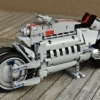Leaderboard
-
in Posts
- All areas
- Videos
- Video Comments
- Files
- File Comments
- File Reviews
- Pipelines Tools
- Pipeline Tool Comments
- Pipeline Tool Reviews
- Databases
- Database Comments
- Database Reviews
- Plugins
- Plugin Comments
- Plugin Reviews
- Images
- Image Comments
- Image Reviews
- Albums
- Album Comments
- Album Reviews
- Topics
- Posts
- Blog Entries
- Blog Comments
- Status Updates
- Status Replies
-
Custom Date
-
All time
May 3 2016 - April 30 2024
-
Year
April 30 2023 - April 30 2024
-
Month
March 30 2024 - April 30 2024
-
Week
April 23 2024 - April 30 2024
-
Today
April 30 2024
-
Custom Date
10/03/2021 - 10/03/2021
-
All time
Popular Content
Showing content with the highest reputation on 10/03/2021 in Posts
-
I was always a hobbyist but I invested a lot of time with this community. I come back because it became part of me and not keeping in touch is somewhat like leaving friends behind. it is difficult. I come back to see some of the old heads.4 points
-
I didn't know where put this post, because it is partially about performance in character animation and partially about Blender. I choose this thread, I hope it's OK 🙂 I did some stress tests in C4D and Blender last week. I think, I experienced everything what I heard before about both softwares. The goal was clear - take a rigged model and make some tests - make a few copies of this model with riggs, add some density enviro to scene, make operation on keys with all bones selected etc. Of course these weren't a huge tests, I didn't touch many areas of 3d soft. But I have some conclusions 🙂 First of all, both programs impressed me. And yes - Blender has a better performance. Generally I have this feeling that all actions made in Blender are "lighter": from selecting objects to working with riggs. And yes - C4D is super user-friendly. And I think this is the price, we have to pay. But I have to mention that I could work with more than one riggs in a scene in C4D. It wasn't smooth, but was possible 🙂 And I think that this wasn't super heavy rigg. What next. Cycles is very nice and Eevee for quick previz is just amazing. I wonder how works Redshift, Octane and now Renderman in Blender. My general impression about C4D - is super solid software, maybe hasn't cool new toys on board, but "basics" work great. One test was pretty interesting. I took a heavy FBX file from Motion Builder. MoBu also has TAKE system and C4D could read all this TAKES - this is great! Blender had some problems with import enviro in proper way and, what is the most important, with import animation. Why? Because animation was in second TAKE in MoBu, not first, and I think Blender imported only first TAKE. I couldn't find the way to choose from which TAKE Blender should import animation data. Maybe there is some way to fix that, if you know a solution, please let me know 🙂 I had a similar problem when I downloaded model with rigg (also FBX) from website and I tried to import it. In C4D I hadn't any problems - everything was super easy, I didn't have to change even singular option during importing process. On the other hand in Blender I didn't find solution for import file with good result. I tried different settings - check that, uncheck another, and any combination didn't work. The only and quick way to import this model to Blender was first import it to C4D and export new FBX from C4D. After this additional step I finally imported the model to Blender 🙂 And it wasn't 100% perfect, there were some problems with bones. But it worked. And for me these two tests are essence. I think that in C4D this basics operations will work great. OK, I will have some problems with performance but I "get to these problems" in easy way 🙂 In Blender first I have a problem but when I will solve this problem, there will be reward for me - better performance for example. I have to add that my PC is rather old one - I bought it 8 years ago. So I can imagine that my experience could be much better 🙂 And of course this was a super quick test, all of these are only my impressions. So, to be honest, I'm surprised and I think both programs are great. I consider using both of them. Thanks!2 points
-
Hi Dave. Thanks for reminding me. I had a lot of fun making that tutorial. Image attached. I'm not doing a lot of 3D these days. I haven't renewed my Modo subscription this year. They've gone a bit like Maxon with mediocre releases of late. Any 3D stuff I do is designing Lego motorcycles using a free online Lego modeller Mecabricks. So I've gone from making 3D Lego models to actually making real ones. I was doing this before but now I'm a bit more serious about it. Attached is my latest creation finished yesterday. Not quite finished as the exhaust hoses are wrong. I'm waiting for some different length hoses to arrive in the post. This is based off someone else's design but I had to deconstruct it based upon some photos they put online back in 2015. 90% their work, 10% mine. Lazareth LM 847. Has a Maserati V8 engine. I've now got about 50 Lego motorcycles in my collection. Glad I'm not still waiting for the Bodypaint / UV Editing updates promised years ago in Cinema 4D. Apart from the interface changes and a couple of small enhancements to the UV tools, nothing much has changed since I jumped ship with the dismal R17 release. Cheers Nigel / 3DKiwi2 points
-
50 pages, omg people that is some long read there. It is nice to see mdoerators let some fiery talk but some of the stuff was really nasty. Yes, seems R25 is thin but I really like the interface changes!2 points
-
I was kinda hoping you could see how to proceed by looking at my suggested topology above. But most parts are made from others. Consider this part here... So I have started this by selecting the most of the perimeter loop on the existing centre piece then ctrl-scaled (or extruded) that out to get an outer loop. Then I split that off, and expanded it to square form, acknowledging the edge flow from the piece above to make sure my edges lined up and I was matching any control loops I had added there... CBR1 point
-
That's not long ago! R13, R14, R15, R16 and R17 R13 unboxed, two DVDs, color stickers (have no idea what they were supposed to be used for), installation guide, cloth to wipe your glasses (I assume) and last, but not the least, a user manual. The latter is very interesting to read, because I always discover a couple of things I either did not know, or have forgotten about, Nothing beats a booklet you can hold in your hand. -Ingvar1 point
-
My primary advice here is 'build it from the same parts as it is in the real world. So that top section is 4 separate parts, though you can start them all from the same model. You just need to patch that top section in the way that is most helpful to your plans, which is like this initially. So, as you can see, most of this started with disc primitives, and expanded from there with regular poly tools and techniques. SDS gets you the curves of course and the box corners / control loops get you the control of them... CBR1 point
-
Last time I checked Redshift licenses weren't transferable.1 point
-
Too much greyish but if it is what the author is after. For me only one or two images made me imagine i was there.1 point
-
yes I remember that. he also had a a great extending pipes tutorial where there were three pipes and they all extended out without coming out from each other. also his cardman which taught motion and he did an orrery tutorial. any old heads remember Rafi in US support. in a post all you had to do was say Rafi and everyone knew who you were talking about. those were the daze.1 point
-
OK, in physical render it should be as simple as making a new standard material with only color, reflectance and transparency channels. Color channel should be 3% off black, reflectance should be Beckmann dielectric glass Fresnel with no specular and about 30% reflection level. In transparency you want to accept defaults, but set brightness / opacity to 98%, IoR model to glass (1.555), and add the brown colour in absorption slot, and set a very low ray depth there, as your glass is not very thick. The lower that value the more dark the colour will be sooner as light enters it. And that's the other thing. Make sure your model has proper actual thickness in the walls, or light won't behave properly. Lastly, all that is for nothing if there is nothing in your scene for the glass to reflect. This can be other scene components, or lights etc, but most people use an HDRI on a sky object to provide these, which can be hidden from camera or not as your scene dictates, with a compositing tag. CBR1 point
-
Nice to see something a little more stylised and creative compared to the usual 'flooded with light' approach.1 point
-
Is there any way to get this to work in Edit/Component mode? For instance, if I want to select a poly from a mesh and constrain snap it on the Y axis, selecting a vertex of another mesh to align it to? In Maya it's easy.. in viewport, select the polygon, select the axis to move in, then hold the v key while clicking on a vertex of another object.1 point
-
To change text fields, buttons, checkboxes etc. you must edit files from here C:\Program Files\Maxon Cinema 4D R25\resource\modules\c4dplugin\schemes in Photoshop. Generally only normal.tif and focus.tif are most important.1 point



